Standing out in the crowded real estate market can be a daunting challenge. As potential buyers and investors become more discerning, traditional marketing methods often fall short. PropVR, a leader in immersive technologies, is redefining how properties are marketed. By integrating augmented reality (AR) and virtual reality (VR) into real estate strategies, PropVR is elevating property showcases, capturing attention, and driving engagement like never before.
Transforming Property Listings with VR
Gone are the days when buyers relied solely on photos and descriptions to assess a property. PropVR’s VR technology brings a new level of interaction with immersive virtual tours. Buyers can explore every property detail from the comfort of their homes, walking through rooms, examining features, and realistically experiencing the layout.
Use Case: Virtual Open Houses
Imagine hosting a virtual open house for global buyers. PropVR’s VR technology offers agents a fully immersive tour, allowing prospective buyers to navigate the property, view it from various angles, and experience different lighting conditions. This accessibility broadens the audience reach, allowing buyers to engage with the property at their own pace.
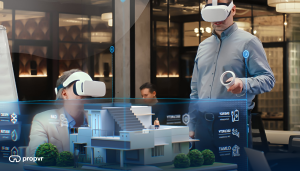
Engaging Buyers with AR
While VR offers a deep dive into a property, AR adds interactivity to real estate marketing. PropVR’s AR technology overlays digital information onto the physical world, enhancing the property viewing experience with interactive features. This lets buyers visualize how furniture or renovations would fit into the space.
Use Case: AR-Enhanced Property Visualization
Buyers can stand in a model home and use their smartphone to see different interior design options in real-time. With PropVR’s AR capabilities, they can view paint colours, furniture layouts, and renovation possibilities, helping them make more informed decisions.
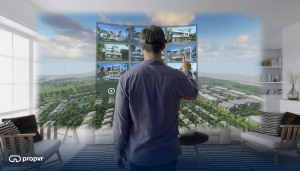
Creating Compelling Marketing Campaigns
PropVR’s immersive technologies enhance property views and provide valuable tools for crafting dynamic marketing campaigns. By incorporating VR and AR, real estate professionals can create content that resonates with buyers and builds a stronger emotional connection with the property.
Use Case: Interactive Marketing Materials
Real estate agents can utilize PropVR’s technology to create interactive brochures, allowing buyers to access VR tours or AR overlays of property features. This makes marketing materials more engaging and provides buyers with a richer, more informative experience.
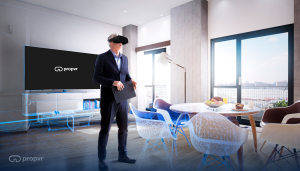
Bridging Online and Offline Experiences
One of PropVR’s most significant advantages is its ability to bridge the gap between online and offline experiences. Buyers can begin their journey with a virtual tour or AR visualization and seamlessly transition to an in-person visit.
Use Case: Seamless Buyer Journey
A buyer who explores a property online can later visit it in person. During the in-person visit, AR can highlight features or show potential design changes, making the buyer’s journey from interest to purchase more fluid and enjoyable.
Leveraging Data for Marketing Success
PropVR not only offers immersive experiences but also provides data insights that can drive more effective marketing strategies. By analyzing how buyers interact with VR and AR content, agents can tailor their marketing efforts to buyer preferences, ensuring higher engagement and conversion rates.
Use Case: Data-Driven Marketing Strategies
Real estate professionals can use insights from VR tours and AR interactions to determine which property features attract the most attention. This data-driven approach ensures that marketing efforts are aligned with buyer interests, resulting in more effective campaigns.
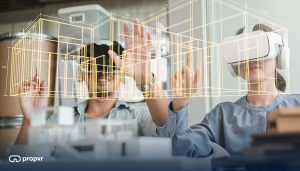
The Future of Real Estate Marketing
As technology advances, immersive marketing will become more integral to real estate. PropVR’s AR and VR solutions lead the way by offering innovative tools to captivate buyers. These technologies are shaping the future of property sales, enhancing buyer engagement and improving overall market success.
Use Case: Future-Forward Marketing Campaigns
PropVR envisions marketing campaigns that fully integrate VR and AR, allowing buyers to explore multiple properties virtually, view AR overlays, and receive personalized recommendations based on preferences.
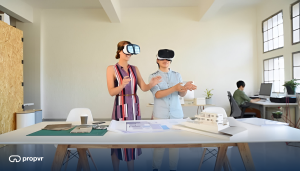
Conclusion: Elevating Real Estate Marketing with PropVR
Innovation and creativity are crucial to standing out in today’s competitive real estate market. PropVR’s AR and VR technologies empower real estate professionals to elevate their marketing strategies and create unforgettable buyer experiences. Agents can capture attention, drive engagement, and achieve sales success by embracing these immersive tools. The future of real estate marketing is immersive, and with PropVR, it’s more impactful than ever before.
